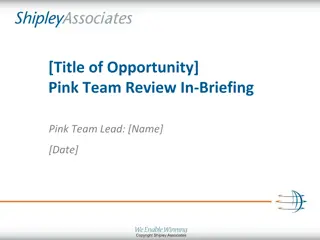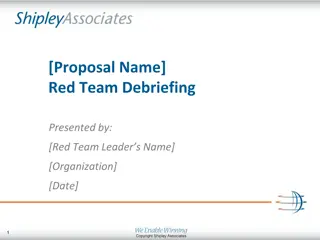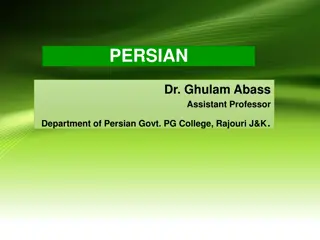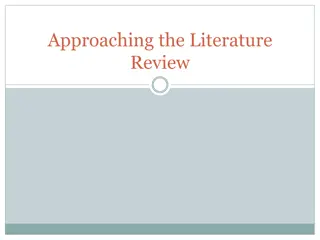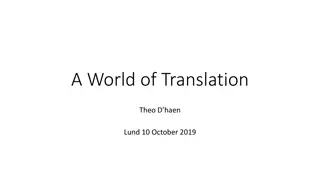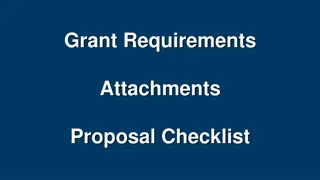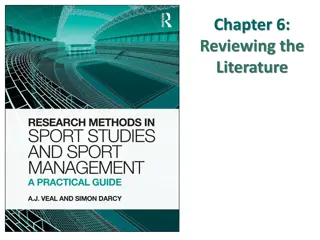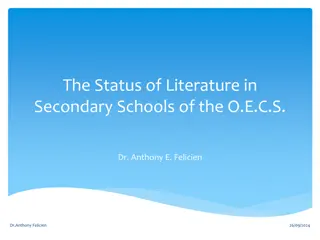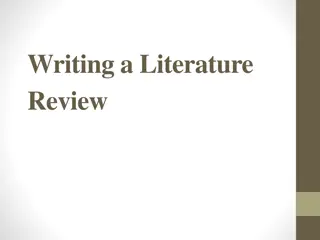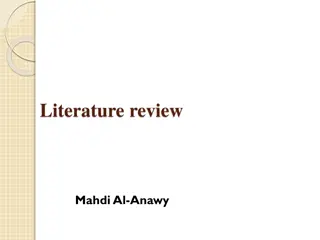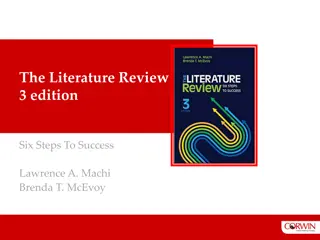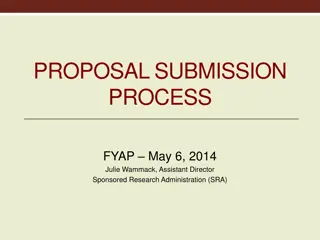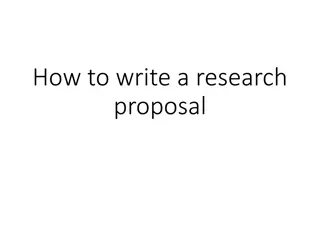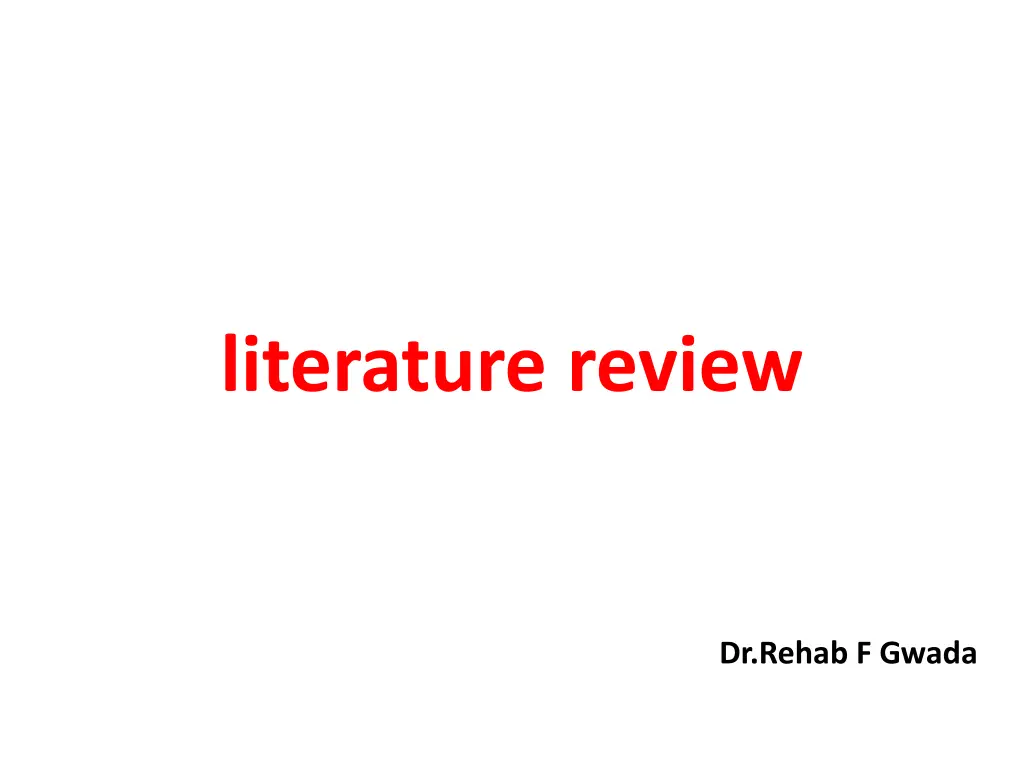
Understanding the Literature Review Process and Its Importance in Research
Discover the significance of a literature review in research, its purpose, types of sources, and the essential steps involved in conducting a comprehensive review of relevant studies. Learn how to select a focused review topic and navigate the literature search process effectively for successful research outcomes.
Uploaded on | 5 Views
Download Presentation

Please find below an Image/Link to download the presentation.
The content on the website is provided AS IS for your information and personal use only. It may not be sold, licensed, or shared on other websites without obtaining consent from the author. If you encounter any issues during the download, it is possible that the publisher has removed the file from their server.
You are allowed to download the files provided on this website for personal or commercial use, subject to the condition that they are used lawfully. All files are the property of their respective owners.
The content on the website is provided AS IS for your information and personal use only. It may not be sold, licensed, or shared on other websites without obtaining consent from the author.
E N D
Presentation Transcript
literature review Dr.Rehab F Gwada
What is a literature review? A literature review is an objective, thorough summary and critical analysis of the relevant available research on the topic being studied. The main aim is to: find out problems that are already investigated and those that need further investigation.
literature review It is an extensive survey of all available past studies relevant to the field of investigation. It gives us knowledge about what others have found out in the related field of study and how they have done so. Remember that, A researcher cannot perform significant research without first understanding the literature in the field (Boote and Beile, 2005: 3)
Purpose of Literature Review . 1. 2. 3. 4. 5. To avoid unnecessary duplication of research. To gain a background knowledge of the research topic To identify variables that may influence the problem to formulate researchable hypothesis. To identify promising procedures , instruments and techniques of analysis. To limit the problem. To Provide comparative results and an interpretative framework for analyzing the finding of the current study. 6. 7.
The types of sources for a review Primary sources Those materials most central to the particular problem being investigated. Secondary sources: Those materials related to problem or area of interest but more peripheral than central to the problem.
The literature review process I. II. Searching the literature. III. Gathering, literature. IV. Synthesis-comparing & contrasting studies, organizing the written review. V. Writing the review. Selecting a review topic. reading and analyzing the
The literature review process Selecting a review topic it is better to start with a narrow and focused topic, and if necessary broaden the scope of the review as you progress. Topics that are too broad will result in reviews that are either too long or too superficial. Start from new material to old, general to specific starting with general topic will provide leads to specific areas of interest and help develop understanding for the interrelationships of research
The literature review process Searching the literature Methods of searching process & their sources: Books , Journals, reports, conference proceedings. Electronic search (Keyword searches are the most common method of identifying literature) - Provide abstract and full-text o Electronic Databases eg. Pubmed , Medline, CINAHL and PsycINFO o Website( Government. and Industry ) o Website for Research Dissertations / Thesis
Cont. Search across multiple databases and information resources. It s not adequate to use Medline as your one and only resource Read the literature throughout the search process. What you read will guide your subsequent searches and refine your topic. Your search should help refine the topic and objective of the overview being written. Save your references, Use a citation manager program like RefWorks or EndNote
The literature review process Gathering, reading and analyzing the literature you have to read each article or book chapter you have chosen carefully, analyze the key points and critically evaluate the information. Methods of recording the information: Summary notes: Condensed records of each part in the article or the study you read. By using the card system Source cards(3 x 5 ) used for noting bibliographic information. Note cards(5 x 8 ) used for actual note taking. Matrix or checklist approach: Columns in which you summarize the headings. research under similar
Read the Material Closer Step 1: read the abstract Decide whether to read the article in detail Step 2: read introduction It explains why the study is important It provides review and evaluation of relevant literature Step 3: read Method with a close, critical eye Focus on participants, measures, procedures Step 4: Evaluate results Do the conclusions seem logical Can you detect any bias on the part of the researcher? Step 5: Take discussion with a grain of salt Edges are smoothed out Pay attention to limitations
The literature review process Synthesis-comparing & contrasting studies, organizing the written review: Characteristics of Good Review: They offer a summary of the process of literature search. They do not simply list relevant studies but they compare, contrast and evaluate their methods and results. They reveal questions gaps or contradictions in previous relevant literature. They should be ordered for each related issues.
Organization of Literature Review: The common organizational pattern: Chronological order-time order Increasing important From general to specific Comparison- similarities and differences You should look for 3 things about the topic: Theory & Facts Methods Opinions decreasing important From specific to general
Literature Review: Example The physical therapist wanting to treat patients using strengthening exercise to increase muscle power ,needs to know: Theories& Facts about how strengthening exercise works Methods that others used to assess effects of strengthening exercise . Opinions of therapists on the future of clinical use of strengthening exercise .
Example structure of literature review Introduction Thesis statement Purpose of the review and concise overview of the research problem Outlines the organisational pattern of the review/sequence of themes covered and the scope of the research Limits, inclusion/exclusion criteria should be clearly outlined. Body Summarisation and Synthesis (discusses and presents findings from the literature) Ensure continuity by summarising each theme/section and present how it relates to following section. Conclusion Concise summary of the findings Presents a rationale for conducting future research Identified gaps in the literature should lead logically onto the purpose of the proposed study (Cronin, Ryan and Coughlan, 2008
How to write the review? There are several ways of presenting the ideas of others within the body of the paper. For Example; If you are want to explore the results of Gwada et al, 2010., it can be written as, 1) Gwada et al, 2010 has suggested that, both CPAP and Bi-PAP are safe well tolerated adjunctive therapy in patients with ACPE. As two approaches have similar effects and produce rapid improvement in hemodynamic variables as well as blood gases when compared with standard oxygen therapy.
How to write the review? 2)According to Gwada et al., 2010 In patients with ACPE, both CPAP and Bi-PAP are safe well tolerated adjunctive therapy. As two approaches have similar effects and produce rapid improvement in hemodynamic variables as well as blood gases when compared with standard oxygen therapy.
How to write the review? 3) Both adjunctive therapy in patients with ACPE. As two approaches have similar effects and produce rapid improvement in hemodynamic variables as well as blood gases when compared with standard oxygen therapy( Gwada et al .,2010). CPAP and Bi-PAP are safe well tolerated 4)The use of Both tolerated adjunctive therapy in patients with ACPE. As two approaches have similar effects and produce rapid improvement in hemodynamic variables as well as blood gases when compared with standard oxygen therapy . CPAP and Bi-PAP are safe well
http://upload.wikimedia.org/wikipedia/commons/thumb/d/d3/Nelumno_nucifera_open_flower_-_botanic_garden_adelaide2.jpg/220px-Nelumno_nucifera_open_flower_-_botanic_garden_adelaide2.jpghttp://upload.wikimedia.org/wikipedia/commons/thumb/d/d3/Nelumno_nucifera_open_flower_-_botanic_garden_adelaide2.jpg/220px-Nelumno_nucifera_open_flower_-_botanic_garden_adelaide2.jpg Question? Question?


